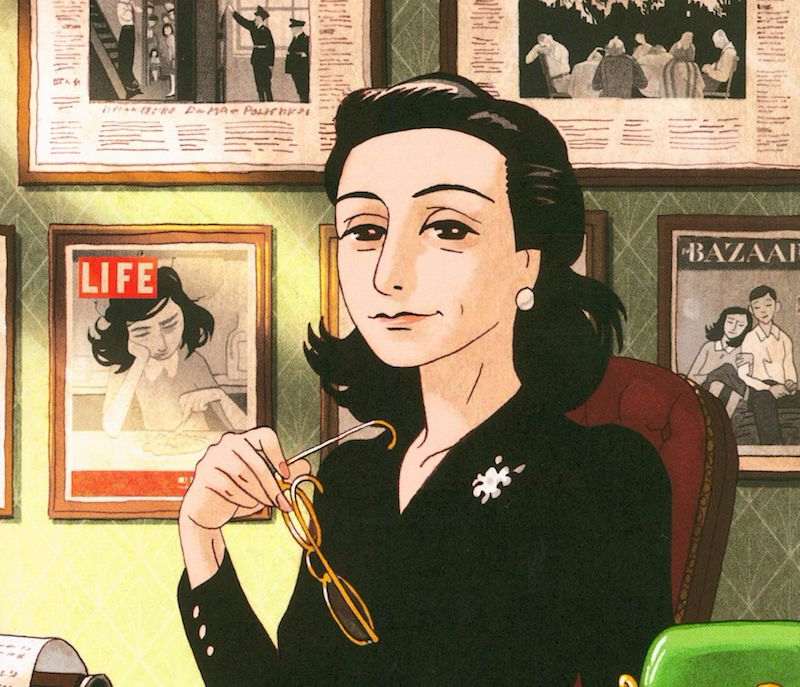Anne Frank Comic Book Made From Diary
Posted on: October 28, 2017

Anne Frank, drawn as the lauded journalist and writer she hoped to become. This Article was originally posted by Dutch newspaper NRC.
New Anne Frank Comic Book Shows Her Thoughts & What She Hoped For
For the first time, an official comic book of Anne Frank’s diary has been published. Israeli film maker Ari Folman (known for the animated film Waltz with Bashir) and draftsman David Polonsky converted the world famous diary-in-letters into a graphic novel. They did so at the request of the Anne Frank Fund in Basel, which owns the rights to the diary. The reason for the authorised Anne Frank comic interpretation is the fact that it was seventy years ago that Anne Frank’s diary first appeared in print. Her father Otto Frank, the only survivor of the family to make it trough war and out of the camps, published Anne’s report of hiding in the backroom in 1947. Among others, after advice from author Cissy van Marxveldt, whose books Anne Frank admired, and were the form on what Anne’s diary letters are based: a (imaginary) girlfriend. (“Cissy of Marxveldt writes bang,” wrote Anne on October 14, 1942).

“When the Nazis came to power, they wanted to remove all the Jews from German society. Even though the Jews only made up 1 percent of the population, still the Nazis believed that we are the root of all evil.” – excerpt from the Anne Frank Comic Book
Catering To A New, Younger Audience
Folman and Polonsky have been working on the project for five years. Initially, he did not see anything in the project, Folman writes in the afterword: what can you add to the diary of the thirteen-year-old that is already world-renowned and written so imaginatively and humorously? The fund of the heir’s of the Frank family also asked him to make an animation film about Anne’s life – coming out next year. That request struck him less hard to do than the stumbling block of the book. The Anne Frank Fund would like to have this Anne Frank comic book (and animation film) to keep the story of Anne and the murderous persecution of the Jews alive among a younger audience, which is more attracted to images than texts due to modern media forms.
Eventually, Folman and Polonsky took on the task of depicting Anne’s diary. They sometimes follow the diary literally, with complete letters, and they place Annes’s text into images with speech bubbles. Like Anne’s description of the eight people living in the Backroom having dinner – all persons being drawn as funny animal species.

The fellow residents and Anne hiding from the Nazis in the Backroom, presented as funny animals.
This is done with the spirit of Anne in mind, not her literal descriptions. There are more of those successful artistic solutions to capture the atmosphere of Anne’s diary. Like her dreams of fear, or how she has continuous criticism about herself – we see Anne in the form of Edvard Munch’s painting The Scream. There is also a portrait of Anne in which we see her later self, as a famous writer and journalist – that she dreamed of becoming: „[…] Will I ever become a writer or journalist again? I hope so, I hope so […]” (April 5, 1944).

Anne Frank imagines herself being one of the famous movie stars of that era.
The unsettling atmosphere in the hiding place, the piercing war news, Anne’s humorous look at fellow residents, her emerging sexuality – they are very successfully captured in comic form. Because her letters are sometimes literally included, you get the feeling close to the written original. The comic book stops where Anne’s diary ends, on August 1, 1944. How they and others are taken out of the Back House three days after and die in the camps, is told briefly in the afterword. In the animation film that Folman made about Anne Frank’s life, he wants to portray her end, he said.
The Anne Frank comic book adaption is 148 pages long and will published in a total of 40 different languages.
Did you find this article interesting? Others who’ve read this article also read: Red Light District History: During The Second World War and 10 Things You Didn’t Know About The Netherlands.







